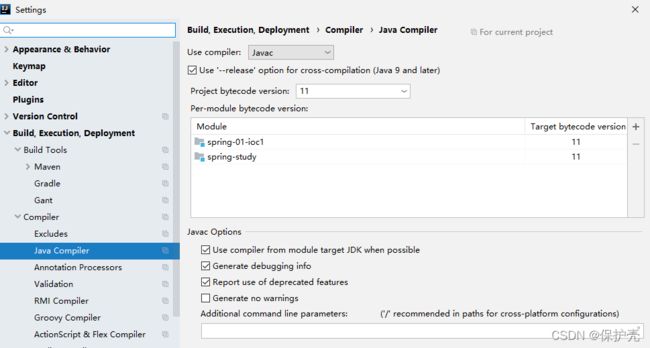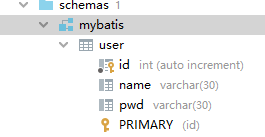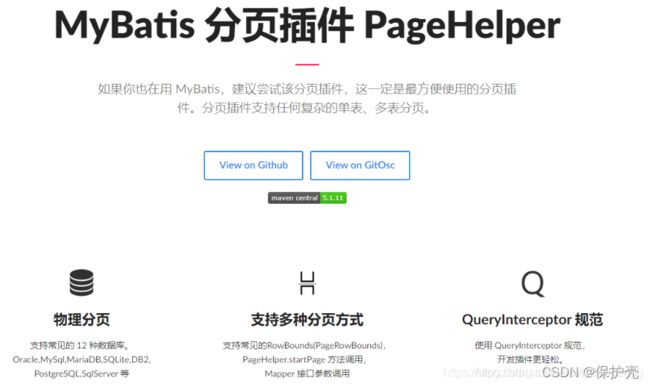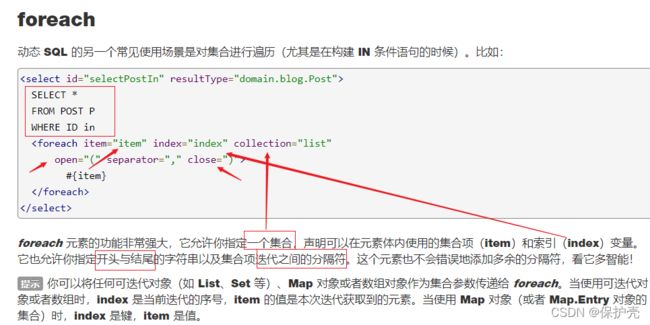Mybatis学习笔记
MyBatis
一、简介
1.1 什么是Mybatis
-
MyBatis 是一款优秀的持久层框架
-
MyBatis 免除了几乎所有的 JDBC 代码以及设置参数和获取结果集的工作。
-
MyBatis 可以通过简单的 XML 或注解来配置和映射原始类型、接口和 Java POJO(Plain Old Java Objects,普通老式 Java 对象)为数据库中的记录
如何获得Mybatis?
maven仓库
<dependency> <groupId>org.mybatisgroupId> <artifactId>mybatisartifactId> <version>3.5.2version> dependency>中文文档:https://mybatis.org/mybatis-3/zh/getting-started.html
1.2.持久化
数据持久化:通常就是指将内存的数据存在硬盘。
-
持久化就是将程序的数据在持久状态和瞬时状态转化的过程,长久保存。
-
内存:断电即失
-
存储:数据库(jabc),io文件持久化
-
生活:冷藏,罐头
-
有一些对象,不能让他丢掉
-
内存太贵了
1.3.持久层
Dao层,Service层,Controller层
- 完成持久化工作的代码块
- 层界限十分明显
mybatis的优点和缺点
- sql语句与代码分离,存放于xml配置文件中:
优点:便于维护管理,不用在java代码中找这些语句;
缺点: JDBC方式可以用打断点的方式调试,但是Mybatis不能,需要通过log4j日志输出日志信息
帮助调试,然后在配置文件中修改。 - 用逻辑标签控制动态SQL的拼接:
优点:用标签代替编写逻辑代码;
缺点:拼接复杂SQL语句时,没有代码灵活,拼写比较复杂。不要使用变通的手段来应对这种复杂
的语句。 - 查询的结果集与java对象自动映射:
优点:保证名称相同,配置好映射关系即可自动映射或者,不配置映射关系,通过配置列名=字段
名也可完成自动映射。
缺点:对开发人员所写的SQL依赖很强。 - 编写原生SQL:
优点:接近JDBC,比较灵活。
缺点:对SQL语句依赖程度很高;并且属于半自动,数据库移植比较麻烦,比如mysql数据库编程
Oracle数据库,部分的sql语句需要调整。 - 最重要的一点,使用的人多!公司需要!但是应为用了反射,效率会下降,所有有些公司会使用原
生的jdbc
二、第一个Mybatis程序
2.1.搭建环境(完整版)
2.1.1 搭建数据库
CREATE DATABASE `mybatis`;
USE `mybatis`;
CREATE TABLE `user`(
`id` INT PRIMARY KEY AUTO_INCREMENT,
`name` VARCHAR(30) DEFAULT NULL,
`pwd` VARCHAR(30) DEFAULT NULL
)ENGINE=INNODB DEFAULT CHARSET=utf8;
INSERT INTO `user`(`name`,`pwd`) VALUES
('张三','123456'),
('李四','123456')
2.1.2 新建项目
1.新建一个普通maven项目
2.删除src目录
3.导入maven依赖
<dependencies>
<dependency>
<groupId>mysqlgroupId>
<artifactId>mysql-connector-javaartifactId>
<version>8.0.21version>
dependency>
<dependency>
<groupId>org.mybatisgroupId>
<artifactId>mybatisartifactId>
<version>3.5.2version>
dependency>
<dependency>
<groupId>junitgroupId>
<artifactId>junitartifactId>
<version>4.12version>
dependency>
dependencies>
<build>
<resources>
<resource>
<directory>src/main/resourcesdirectory>
<includes>
<include>**/*.propertiesinclude>
<include>**/*.xmlinclude>
includes>
<filtering>truefiltering>
resource>
<resource>
<directory>src/main/javadirectory>
<includes>
<include>**/*.propertiesinclude>
<include>**/*.xmlinclude>
includes>
<filtering>truefiltering>
resource>
resources>
build>
<properties>
<project.build.sourceEncoding>UTF-8project.build.sourceEncoding>
<maven.compiler.encoding>UTF-8maven.compiler.encoding>
<java.version>11java.version>
<maven.compiler.source>11maven.compiler.source>
<maven.compiler.target>11maven.compiler.target>
properties>
2.2.创建一个模块
2.2.1 编写mybatis的核心配置文件
可以命名为:mybatis-config.xml,放在resource目录下
DOCTYPE configuration
PUBLIC "-//mybatis.org//DTD Config 3.0//EN"
"http://mybatis.org/dtd/mybatis-3-config.dtd">
<configuration>
<properties resource="db.properties"/>
<typeAliases>
<package name="com.project.pojo"/>
typeAliases>
<environments default="development">
<environment id="development">
<transactionManager type="JDBC"/>
<dataSource type="POOLED">
<property name="driver" value="${driver}"/>
<property name="url" value="${url}"/>
<property name="username" value="${username}"/>
<property name="password" value="${password}"/>
dataSource>
environment>
environments>
<mappers>
<mapper resource="com/project/dao/UserMapper.xml"/>
mappers>
configuration>
导入外部文件db.properties
driver=com.mysql.cj.jdbc.Driver
url=jdbc:mysql://localhost/mybatis?serverTimezone=UTC&characterEncoding=utf8&useUnicode=true&useSSL=false
username=root
password=123456
2.2.2 编写mybatis工具类
public class MyBatisUtils {
private static SqlSessionFactory sqlSessionFactory;
static{
try {
String resource = "mybatis-config.xml";
//获取mybatis第一步:获取sqlSessionFactory
InputStream inputStream = Resources.getResourceAsStream(resource);
sqlSessionFactory = new SqlSessionFactoryBuilder().build(inputStream);
} catch (IOException e) {
e.printStackTrace();
}
}
//既然有了 SqlSessionFactory,顾名思义,我们可以从中获得 SqlSession 的实例。
//SqlSession 提供了在数据库执行 SQL 命令所需的所有方法
public static SqlSession getSqlSession(){
return sqlSessionFactory.openSession();
}
}
2.2.3 Dao接口
public interface UserMapper {
//获取全部用户
List<User> getUserList();
//根据ID查询用户
User getById(int id);
//insert一个用户
int addUser(User user);
//修改用户
int updateUser(User user);
//删除一个用户
int deleteUser(int id);
}
2.2.4 Mapper配置文件
- 接口实现类由原来的UserDaoImpl转变称为一个Mapper配置文件
DOCTYPE mapper
PUBLIC "-//mybatis.org//DTD Mapper 3.0//EN"
"http://mybatis.org/dtd/mybatis-3-mapper.dtd">
//注意这里
<mapper namespace="com.project.dao.UserMapper">
<select id="getUserList" resultType="User">
select * from mybatis.user
select>
<select id="getById" parameterType="int" resultType="com.project.pojo.User" >
select * from mybatis.user where id = #{id}
select>
<insert id="addUser" parameterType="com.project.pojo.User">
insert into mybatis.user (name,pwd) value(#{name},#{pwd});
insert>
<update id="updateUser" parameterType="com.project.pojo.User">
update mybatis.user set name=#{name},pwd=#{pwd} where id = #{id};
update>
<delete id="deleteUser" parameterType="int">
delete from mybatis.user where id = #{id}
delete>
mapper>
2.3测试
注意点:org.apache.ibatus.BindingException
核心配置文件中注册mappers
- junit测试
public class UserMapperTest {
@Test
public void test(){
//1.获得SqlSession对象
SqlSession sqlSession = MyBatisUtils.getSqlSession();
//方式一
UserMapper userMapper = sqlSession.getMapper(UserMapper.class);
List<User> userList = userMapper.getUserList();
//方式二:
// List userList = sqlSession.selectList("com.project.dao.UserDao.getUserList");
for (User user : userList) {
System.out.println(user);
}
//关闭Session
sqlSession.close();
}
//增删改查需要提交事务
@Test
public void addUser(){
SqlSession sqlSession = MyBatisUtils.getSqlSession();
UserMapper mapper = sqlSession.getMapper(UserMapper.class);
int res = mapper.addUser(new User(null, "admin", "admin"));
if(res>0){
System.out.println("插入成功!");
}
//提交事务
sqlSession.commit();
sqlSession.close();
}
2.4 可能会遇到的问题:
1.版本错误–绑定好jdk11
https://blog.csdn.net/cyberpunk_Isme/article/details/107766453

<properties>
<project.build.sourceEncoding>UTF-8project.build.sourceEncoding>
<maven.compiler.encoding>UTF-8maven.compiler.encoding>
<java.version>11java.version>
<maven.compiler.source>11maven.compiler.source>
<maven.compiler.target>11maven.compiler.target>
properties>
2.maven导出资源问题
<build>
<resources>
<resource>
<directory>src/main/resourcesdirectory>
<includes>
<include>**/*.propertiesinclude>
<include>**/*.xmlinclude>
includes>
<filtering>truefiltering>
resource>
<resource>
<directory>src/main/javadirectory>
<includes>
<include>**/*.propertiesinclude>
<include>**/*.xmlinclude>
includes>
<filtering>truefiltering>
resource>
resources>
build>
三、CRUD
简单的梳理逻辑
- SqlSessionFactoryBuilder().build(inputStream)-读取核心配置文件,
- 核心配置文件负责核心配置,重要的一点是通过核心配置找到Mapper的xml文件。
- xml文件通过 namespace 又能找到 对应的接口文件。
- 有了方法,有了sql,会用动态代理,生成代理类,实现对象的方法。
- session.getMapper(UserMapper.class) 获取的就是代理对象,当然就有了对应的实现。
1.namespacce
namespace中包名要和Dao/mapper接口的包名一致!
2.select
- id:制定对应的方法,就是你的告诉我你这sql对应的是哪个方法
- resultType:Sql语句执行的返回值,期望从这条语句中返回结果的类全限定名或别名。
- parameterType:,将会传入这条语句的参数的类全限定名或别名。这个属性是可选的,基本数据类型可以不写
1.编写接口
//根据ID查询用户
User getById(int id);
2.编写对应的mapper中的sql语句
<select id="getById" parameterType="int" resultType="com.project.pojo.User" >
select * from mybatis.user where id = #{id}
</select>
3.测试
public void getById(){
//1.获得SqlSession对象
SqlSession sqlSession = MyBatisUtils.getSqlSession();
UserMapper mapper = sqlSession.getMapper(UserMapper.class);
User user = mapper.getById(1);
System.out.println(user);
sqlSession.close();
}
3. Insert
4. update
5. Delete
6. 万能Map
假设,我们的实体类,或者数据库中的表,字段或者参数过多,我们应该考虑使用Map!
1.UserMapper接口
//用万能Map插入用户public void addUser2(Map map);
2.UserMapper.xml
<!--对象中的属性可以直接取出来 传递map的key--><insert id="addUser2" parameterType="map"> insert into user (id,name,password) values (#{userid},#{username},#{userpassword})</insert>
3.测试
@Test
public void test3(){
SqlSession sqlSession = MybatisUtils.getSqlSession();
UserMapper mapper = sqlSession.getMapper(UserMapper.class);
HashMap<String, Object> map = new HashMap<String, Object>();
map.put("userid",4);
map.put("username","王虎");
map.put("userpassword",789);
mapper.addUser2(map);
//提交事务
sqlSession.commit();
//关闭资源
sqlSession.close();
}
Map传递参数,直接在sql中取出key即可! 【parameter=“map”】
对象传递参数,直接在sql中取出对象的属性即可! 【parameter=“Object”】
只有一个基本类型参数的情况下,可以直接在sql中取到
多个参数用Map , 或者注解!
7. 模糊查询
模糊查询这么写?
1.Java代码执行的时候,传递通配符% %
List<User> userList = mapper.getUserLike("%李%");
2.在sql拼接中使用通配符
select * from user where name like "%"#{value}"%"
为什么要使用双引号?
8.传入多个参数
思考,如果参数没有传实体类而是传了多个参数,能不能执行?
int addUser(@Param("id") int id,@Param("username") String
name,@Param("password") String pws);
结论: 多个参数时,使用@Param注解,能制定对应的参数,当然如果能封装对象最好封装对象
四、配置解析
1. 核心配置文件
- mybatis-config.xml
- Mybatis的配置文件包含了会深深影响MyBatis行为的设置和属性信息。
configuration(配置) properties(属性) settings(设置) typeAliases(类型别名) typeHandlers(类型处理器) objectFactory(对象工厂) plugins(插件) environments(环境配置) environment(环境变量) transactionManager(事务管理器) dataSource(数据源) databaseIdProvider(数据库厂商标识) mappers(映射器)
2. 环境配置 environments
MyBatis 可以配置成适应多种环境
不过要记住:尽管可以配置多个环境,但每个 SqlSessionFactory 实例只能选择一种环境
学会使用配置多套运行环境!
MyBatis默认的事务管理器就是JDBC ,连接池:POOLED
3. 属性 properties
我们可以通过properties属性来实现引用配置文件
这些属性可以在外部进行配置,并可以进行动态替换。你既可以在典型的 Java 属性文件中配置这些属性,也可以在 properties 元素的子元素中设置。【db.poperties】
1.编写一个配置文件
db.properties
driver=com.mysql.cj.jdbc.Driverurl=jdbc:mysql://localhost/mybatis?serverTimezone=UTC&characterEncoding=utf8&useUnicode=true&useSSL=falseusername=rootpassword=123456
1.可以直接引入外部文件
2.可以在其中增加一些属性配置
3.如果两个文件有同一个字段,优先使用外部配置文件的
4、类型别名(typeAliases)
-
类型别名可为 Java 类型设置一个缩写名字。
-
存在的意义仅在于用来减少类完全限定名的冗余。
<typeAliases> <typeAlias type="com.project.pojo.User" alias="User"/> typeAliases>
也可以指定一个包名,MyBatis 会在包名下面搜索需要的 Java Bean,比如:
扫描实体类的包,它默认别名就是这个类的类名,首字母小写。
<typeAliases> <package name="com.project.pojo"/> typeAliases>
在实体类比较少的时候,使用第一种方式。
如果实体类十分多,建议使用第二种
第一种可以DIY别名,第二种则不行,如果有非要改,需要在实体上增加注解
@Ajias("user")public class User{}
5.设置
这是 MyBatis 中极为重要的调整设置,它们会改变 MyBatis 的运行时行为。

6.其他配置
- typeHandlers(类型处理器)
- objectFactory(对象工厂)
- [plugins(插件)]
- mybatis-generator-core
- mabatis-plus
- 通用mapper
7.映射器(mappers)
MapperRegistry:注册绑定我们的Mapper文件
方式 一:【推荐使用】(使用相对于类路径的资源引用)
<mappers>
<mapper resource="com/project/dao/UserMapper.xml"/>
mappers>
方式二:使用class文件绑定注册(使用注解时使用)
<mappers>
<mapper class="com.project.dao.UserMapper">mapper>
mappers>
注意点:
- 接口和他的Mapper配置文件必须同名
- 接口和他的Mapper配置文件必须在同一个包下!
方式三:使用扫描包进行注入绑定
<mappers>
<package name="com.project.dao"/>
mappers>
【实战提示:mapper标签中,xml用resource,注解要用class,或者用包扫描】
8.生命周期和作用域
生命周期,和作用域,是至关重要的,因为错误的使用会导致非常严重的并发问题。
SqlSessionFactoryBuilder:
- 一旦创建了sqlSessionFactory,就不再需要它了
- 局部变量
SqlSessionFactory
- 说白了就是可以想象为:数据库连接池
- SqlSessionFactory 一旦被创建就应该在应用的运行期间一直存在,没有任何理由丢弃它或重新创建另一个实例。
- 因此 SqlSessionFactory 的最佳作用域是应用作用域。
- 最简单的就是使用单例模式或者静态单例模式。
SqlSession
- 连接到连接池的一个请求
- SqlSession 的实例不是线程安全的,因此是不能被共享的,所以它的最佳的作用域是请求或方法作用域。
- 用完之后需要赶紧关闭,否则资源被占用!
这里面的每一个Mapper,就代表一个具体的业务!
五、解决属性名和字段名不一致的问题
1.问题
数据库的字段
新建一个项目,拷贝之前的,测试实体类字段不一样的情况
public class User { private Integer id; private String name; private String password;}
测试问题
[外链图片转存失败,源站可能有防盗链机制,建议将图片保存下来直接上传(img-o0MO4yBC-1639621557873)(Mybatis笔记.assets/image-20210217214532122.png)]
// select * from mybatis.user where id = #{id}
//类型处理器
//select name,pwd from mybatis.user where id = #{id}
解决方法:
-
起别名
<select id="getById" parameterType="int" resultType="com.project.pojo.User" > select id,name,pwd as password from mybatis.user where id = #{id} select> -
结果集映射- > resultMap
id name pwd
id name password
<resultMap id="UserMap" type="User">
<result column="id" property="id"/>
<result column="name" property="name"/>
<result column="pwd" property="password"/>
resultMap>
<select id="getById" resultMap="UserMap" >
select * from mybatis.user where id = #{id}
select>
<settings>
<!--开启驼峰命名规则-->
<setting name="mapUnderscoreToCamelCase" value="true"/>
</settings>
resultMap元素是 MyBatis 中最重要最强大的元素。- ResultMap 的设计思想是,对简单的语句做到零配置,对于复杂一点的语句,只需要描述语句之间的关系就行了。
- ResultMap最优秀之处在于,虽然你已经对它相当了解了,但是根本就不需要显示地用到他们。
- 如果这个世界总是这么简单就好了。
六、日志
6.1 日工厂
如果一个数据库操作出现了异常,我们需要排错。日志就是最好的助手!
曾经:sout,debug
现在:日志工厂
- SLF4J
- LOG4J 【掌握】
- LOG4J2
- JDK_LOGGING
- COMMONS_LOGGING
- STDOUT_LOGGING 【掌握】
- NO_LOGGING
在mybatis中具体使用 哪一个日志实现,在设置中设定!
STDOUT_LOGGING 标准日志输出
排序问题:
在mybatis核心配置文件中,配置我们的日志!
6.2 Log4j
什么是Log4j?
- Log4j是Apache的一个开源项目,通过使用Log4j,我们可以控制日志信息输送的目的地是控制台、文件、GUI组件
- 我们也可以控制每一条日志的输出格式
- 通过定义每一条日志信息的级别,我们能够更加细致地控制日志的生成过程。
- 通过一个配置文件来灵活地进行配置,而不需要修改应用的代码。
1.先导入log4j的包
<dependency> <groupId>log4jgroupId> <artifactId>log4jartifactId> <version>1.2.17version>dependency><dependency><groupId>org.slf4jgroupId><artifactId>slf4j-nopartifactId><version>1.7.30version>dependency>
2.log4j.properties
#将等级为DEBUG的日志信息输出到console和file这两个目的地,console和file的定义在下面的代码log4j.rootLogger=DEBUG,console,file#控制台输出的相关设置log4j.appender.console = org.apache.log4j.ConsoleAppenderlog4j.appender.console.Target = System.outlog4j.appender.console.Threshold=DEBUGlog4j.appender.console.layout = org.apache.log4j.PatternLayoutlog4j.appender.console.layout.ConversionPattern=[%c]-%m%n#文件输出的相关设置log4j.appender.file = org.apache.log4j.RollingFileAppenderlog4j.appender.file.File=./log/rzp.loglog4j.appender.file.MaxFileSize=10mblog4j.appender.file.Threshold=DEBUGlog4j.appender.file.layout=org.apache.log4j.PatternLayoutlog4j.appender.file.layout.ConversionPattern=[%p][%d{yy-MM-dd}][%c]%m%n#日志输出级别log4j.logger.org.mybatis=DEBUGlog4j.logger.java.sql=DEBUGlog4j.logger.java.sql.Statement=DEBUGlog4j.logger.java.sql.ResultSet=DEBUGlog4j.logger.java.sq1.PreparedStatement=DEBUG
6.3 配置settings为log4j实现
<settings> <setting name="logImpl" value="LOG4J"/> settings>
6.4 测试运行
Log4j简单使用
1.在要使用Log4j的类中,导入包 import org.apache.log4j.Logger;
2.日志对象,参数为当前类的class对象
static Logger logger = Logger.getLogger(UserDaoTest.class);
3.日志级别
logger.info("info: 测试log4j");logger.debug("debug: 测试log4j");logger.error("error:测试log4j");
1.info
2.debug
3.erro
七、分页
思考:为什么分页?
- 减少数据的处理量
7.1 使用Limit分页
语法:SELECT * from user limit startIndex,pageSize;select * from user limit 3;#[0,n]
使用MyBatis实现分页,核心SQL
1.接口
//分页List getUserByLimit(Map map);
2.Mapper.xml
<!--分页查询-->
<select id="getUserByLimit" parameterType="map" resultMap="UserMap">
select * from user limit #{startIndex},#{pageSize}
</select>
3.测试
@Test
public void getUserByLimit(){
SqlSession sqlSession = MybatisUtils.getSqlSession();
UserMapper mapper = sqlSession.getMapper(UserMapper.class);
HashMap<String, Integer> map = new HashMap<String, Integer>();
map.put("startIndex",1);
map.put("pageSize",2);
List<User> list = mapper.getUserByLimit(map);
for (User user : list) {
System.out.println(user);
}
}
7.2 RowBounds分页
不再使用SQL实现分页
1.接口
//分页2
List<User> getUserByRowBounds();
2.mapper.xml
<!--分页查询2-->
<select id="getUserByRowBounds">
select * from user limit #{startIndex},#{pageSize}
</select>
3.测试
public void getUserByRowBounds(){
SqlSession sqlSession = MybatisUtils.getSqlSession();
//RowBounds实现
RowBounds rowBounds = new RowBounds(1, 2);
//通过Java代码层面实现分页
List<User> userList = sqlSession.selectList("com.kaung.dao.UserMapper.getUserByRowBounds", null, rowBounds);
for (User user : userList) {
System.out.println(user);
}
sqlSession.close();
}
7.3 分页插件
了解即可
八、使用注解开发
8.1 面向接口开发
三个面向区别
- 面向对象是指,我们考虑问题时,以对象为单位,考虑它的属性和方法;
- 面向过程是指,我们考虑问题时,以一个具体的流程(事务过程)为单位,考虑它的实现;
- 接口设计与非接口设计是针对复用技术而言的,与面向对象(过程)不是一个问题,更多的体现就是对系统整体的架构;
8.2 使用注解开发
1.注解在接口上实现
@Select("select * from user")
List<User> getUsers();
12
2.需要在核心配置文件中绑定接口
<mappers>
<mapper class="com.kuang.dao.UserMapper"/>
</mappers>
123
3.测试
本质:反射机制实现
底层:动态代理
![]()
MyBatis详细执行流程
![]()
8.3 注解CURD
我们可以在工具类创建的时候实现自动提交事务!
public static SqlSession getSqlSession(){ return sqlSessionFactory.openSession(true); }
编写接口,增加注解
@Select("select * from user") List<User> getUsers(); //方法存在多个参数,所有的参数前面必须加上@Param("id")注解 //调用时以注解的参数为主 @Select("select * from user where id = #{id}") User getById(@Param("id") int id); @Insert("insert into user(id,name,pwd) values(#{id},#{name},#{password})") int addUser(User user); @Update("update user set name=#{name},pwd=#{password} where id = #{id}") int updateUser(User user); @Delete("delete from user where id = #{uid}") int deleteUser(@Param("uid") int id);
测试类
【注意:我们必须要将接口注册绑定到我们的核心配置文件中!】
关于@Param( )注解
-
基本类型的参数或者String类型,需要加上
-
引用类型不需要加
-
如果只有一个基本类型的话,可以忽略,但是建议大家都加上
-
我们在SQL中引用的就是我们这里的@Param()中设定的属性名
#{} 和 ${}区别:#{}防止SQL注入
九、Lombok
Lombok项目是一个Java库,它会自动插入编辑器和构建工具中,Lombok提供了一组有用的注释,用来消除Java类中的大量样板代码。仅五个字符(@Data)就可以替换数百行代码从而产生干净,简洁且易于维护的Java类。
使用步骤:
1.在IDEA中安装Lombok插件
2.在项目中导入lombok的jar包
<dependency>
<groupId>org.projectlombok</groupId>
<artifactId>lombok</artifactId>
<version>1.18.10</version>
<scope>provided</scope>
</dependency>
3在程序上加注解
@Getter and @Setter
@FieldNameConstants
@ToString
@EqualsAndHashCode
@AllArgsConstructor, @RequiredArgsConstructor and @NoArgsConstructor
@Log, @Log4j, @Log4j2, @Slf4j, @XSlf4j, @CommonsLog, @JBossLog, @Flogger, @CustomLog
@Data
@Builder
@SuperBuilder
@Singular
@Delegate
@Value
@Accessors
@Wither
@With
@SneakyThrows
@val
说明:
@Data
@AllArgsConstructor
@NoArgsConstructor
public class User {
private int id;
private String name;
private String password;
}
![]()
十、多对一处理
多对一:
- 多个学生对应一个老师
- 对于学生而言,关联…多个学生关联一个老师【多对一】
- 对于老师而言,集合…一个老师有很多学生【一对多】
[外链图片转存失败,源站可能有防盗链机制,建议将图片保存下来直接上传(img-PJTK7n97-1639621557876)(Mybatis笔记.assets/image-20210219100858208.png)]
SQL:
CREATE TABLE teacher( `id` INT(10) PRIMARY KEY AUTO_INCREMENT, `name` VARCHAR(30) DEFAULT NULL)ENGINE=INNODB DEFAULT CHARSET=utf8;INSERT INTO teacher(`id`,`name`) VALUES(1,'秦老师');CREATE TABLE student( `id` INT(10) PRIMARY KEY AUTO_INCREMENT, `name` VARCHAR(30) DEFAULT NULL, `tid` INT(10) DEFAULT NULL, CONSTRAINT `s_tid` FOREIGN KEY (`tid`) REFERENCES teacher(id))ENGINE=INNODB DEFAULT CHARSET=utf8;INSERT INTO student(`id`,`name`,`tid`) VALUES('1','小明','1');INSERT INTO student(`id`,`name`,`tid`) VALUES('2','小红','1');INSERT INTO student(`id`,`name`,`tid`) VALUES('3','小张','1');INSERT INTO student(`id`,`name`,`tid`) VALUES('4','小李','1');INSERT INTO student(`id`,`name`,`tid`) VALUES('5','小王','1');
1. 测试环境搭建
1.导入lombok
2.新建实体类Teacher,Student
3.建立Mapper接口
4.建立Mapper.xml文件
5.在核心配置文件中绑定注册我们的Mapper接口或者文件 【方式很多,随心选】
【实战提示:mapper标签中,xml用resource,注解要用class,或者用包扫描】
6.测试查询是否能够成功
2. 按照查询嵌套处理
<select id="getStudent" resultMap="StudentTeacher"> select * from studentselect><resultMap id="StudentTeacher" type="student"> <result property="id" column="id"/> <result property="name" column="name"/> <collection property="teacher" column="tid" javaType="teacher" select="getTeacher"/>resultMap><select id="getTeacher" resultType="teacher"> select * from teacher where id = #{id}select>
3.按照结果嵌套处理
<select id="getStudent2" resultMap="StudentTeacher2">
select s.id sid , s.name sname, t.name tname
from student s,teacher t
where s.tid=t.id
select>
<resultMap id="StudentTeacher2" type="student">
<result property="id" column="sid"/>
<result property="name" column="sname"/>
<association property="teacher" javaType="teacher">
<result property="name" column="tname">result>
association>
resultMap>
回顾Mysql多对一查询方式:
- 子查询 (按照查询嵌套)
- 联表查询 (按照结果嵌套)
11、一对多处理
比如:一个老师拥有多个学生
对于老师而言,就是一对多的关系!
1. 环境搭建
实体类
@Data
public class Student {
private int id;
private String name;
private int tid;
}
@Data
public class Teacher {
private int id;
private String name;
//一个老师拥有多个学生
private List<Student> students;
}
2. 按照结果嵌套嵌套处理
<!--按结果嵌套查询-->
<select id="getTeacher" resultMap="StudentTeacher">
SELECT s.id sid, s.name sname,t.name tname,t.id tid
FROM student s, teacher t
WHERE s.tid = t.id AND tid = #{tid}
</select>
<resultMap id="StudentTeacher" type="Teacher">
<result property="id" column="tid"/>
<result property="name" column="tname"/>
<!--复杂的属性,我们需要单独处理 对象:association 集合:collection
javaType=""指定属性的类型!
集合中的泛型信息,我们使用ofType获取
-->
<collection property="students" ofType="Student">
<result property="id" column="sid"/>
<result property="name" column="sname"/>
<result property="tid" column="tid"/>
</collection>
</resultMap>
按照查询嵌套处理
<select id="getTeacher2" resultMap="TeacherStudent2">
select * from mybatis.teacher where id= #{tid}
select>
<resultMap id="TeacherStudent2" type="Teacher">
<collection property="students" javaType="ArrayList" ofType="Student" select="getStudentByTeacherId" column="id"/>
resultMap>
<select id="getStudentByTeacherId" resultType="Student">
select * from mybatis.student where tid = #{tid}
select>
小结
1.关联 - association 【多对一】
2.集合 - collection 【一对多】
3.javaType & ofType
- JavaType用来指定实体类中的类型
- ofType用来指定映射到List或者集合中的pojo类型,泛型中的约束类型
** 注意点:**
- 保证SQL的可读性,尽量保证通俗易懂
- 注意一对多和多对一,属性名和字段的问题
- 如果问题不好排查错误,可以使用日志,建议使用Log4j
面试高频
-
Mysql引擎
-
InnoDB底层原理
-
索引
-
索引优化
12、动态SQL
什么是动态SQL:动态SQL就是根据不同的条件生成不同的SQL语句
所谓的动态SQL,本质上还是SQL语句,只是我们可以在SQL层面,去执行一个逻辑代码
如果你之前用过 JSTL 或任何基于类 XML 语言的文本处理器,你对动态 SQL 元素可能会感觉似曾相识。在 MyBatis 之前的版本中,需要花时间了解大量的元素。借助功能强大的基于 OGNL 的表达式,MyBatis 3 替换了之前的大部分元素,大大精简了元素种类,现在要学习的元素种类比原来的一半还要少。ifchoose (when, otherwise)trim (where, set)foreach
搭建环境
CREATE TABLE blog ( `id` VARCHAR(50) NOT NULL COMMENT '博客id', `title` VARCHAR(30) NOT NULL COMMENT '博客标题', `author` VARCHAR(30) NOT NULL COMMENT '博客作者', `create_time` DATETIME(0) NOT NULL COMMENT '创建时间', `views` INT(30) NOT NULL COMMENT '浏览量', PRIMARY KEY (`id`))
创建一个基础工程
1.导包
2.编写配置文件
3.编写实体类
@Datapublic class Blog { private int id; private String title; private String author; private Date createTime;// 属性名和字段名不一致 private int views;}
解决属性名跟字段名不一致的方法:
<settings>
<setting name="logImpl" value="STDOUT_LOGGING"/>
//
<setting name="mapUnderscoreToCamelCase" value="true"/>
settings>
4.编写实体类对应Mapper接口和Mapper.xml文件
IF
<select id="queryBlogIF" parameterType="map" resultType="blog">
select * from blog
<where>
<if test="title!=null">
and title = #{title}
</if>
<if test="author!=null">
and author = #{author}
</if>
</where>
</select>
choose (when, otherwise)
<select id="queryBlogChoose" parameterType="map" resultType="blog">
select * from blog
<where>
<choose>
<when test="title != null">
title =#{title}
when>
<when test="author != null">
and author = #{author}
when>
<otherwise>
and views = #{views}
otherwise>
choose>
where>
select>
trim(where、set)
- where 元素只会在子元素返回任何内容的情况下才插入 “WHERE” 子句。而且,若子句的开头为 “AND” 或 “OR”,where 元素也会将它们去除。
<select id="queryBlog" parameterType="map" resultType="blog" >
select * from blog where 1=1
<if test="title != null">
and title = #{title}
if>
<if test="author != null">
and author = #{author}
if>
select>
- set 元素会动态地在行首插入 SET 关键字,并会删掉额外的逗号(这些逗号是在使用条件语句给列赋值时引入的).
update blog
title = #{title},
author = #{author}
where id =#{id}
有的时候,我们可能会将一些功能的部分抽取出来,方便服用!
1.使用SQL标签抽取公共部分可
<sql id="if-title-author"> <if test="title!=null"> title = #{title} </if> <if test="author!=null"> and author = #{author} </if></sql>
2.在需要使用的地方使用Include标签引用即可
<select id="queryBlogIF" parameterType="map" resultType="blog">
select * from blog
<where>
<include refid="if-title-author"></include>
</where>
</select>
注意事项:
- 最好基于单表来定义SQL片段(即不要做太复杂的事情)
- 不要存在where标签
Foreach
select * from user where 1=1 and
<foreach item="item" collection="ids"
open="(" separator="or" close=")">
#{id}
foreach>
(id =1 or id=2 or id=3)
<select id="queryBlogForeach" parameterType="map" resultType="blog">
select * from blog
<where>
<foreach collection="ids" item="id" open="and (" close=")" separator="or">
id =#{id}
foreach>
where>
select>
动态SQL就是在拼接SQL语句,我们只要保证SQL的正确性,按照SQL的格式,去排列组合就可以了
建议:
- 先在Mysql中写出完整的SQL,再对应的去修改成我们的动态SQL实现通用即可
13、缓存
13.1 简介
查询 : 连接数据库,耗资源
一次查询的结果,给他暂存一个可以直接取到的地方 --> 内存:缓存
我们再次查询的相同数据的时候,直接走缓存,不走数据库了
1.什么是缓存[Cache]?
①存在内存中的临时数据
②将用户经常查询的数据放在缓存(内存)中,用户去查询数据就不用从磁盘上(关系型数据库文件)查询,从缓存中查询,从而提高查询效率,解决了高并发系统的性能问题
2.为什么使用缓存?
①减少和数据库的交互次数,减少系统开销,提高系统效率
3.什么样的数据可以使用缓存?
① 经常查询并且不经常改变的数据 【可以使用缓存】
13.2 MyBatis缓存
- MyBatis包含一个非常强大的查询缓存特性,它可以非常方便的定制和配置缓存,缓存可以极大的提高查询效率。
- MyBatis系统中默认定义了两级缓存:一级缓存和二级缓存
- 默认情况下,只有一级缓存开启(SqlSession级别的缓存,也称为本地缓存)
- 二级缓存需要手动开启和配置,他是基于namespace级别的缓存。
- 为了提高可扩展性,MyBatis定义了缓存接口Cache。我们可以通过实现Cache接口来定义二级缓存。
13.3 一级缓存
- 一级缓存也叫本地缓存:SqlSession
- 与数据库同一次会话期间查询到的数据会放在本地缓存中
- 以后如果需要获取相同的数据,直接从缓存中拿,没必要再去查询数据库
测试步骤:
1.开启日志
2.测试在一个Session中查询两次记录
@Test
public void test1() {
SqlSession sqlSession = MybatisUtils.getSqlSession();
UserMapper mapper = sqlSession.getMapper(UserMapper.class);
User user = mapper.getUserById(1);
System.out.println(user);
System.out.println("=====================================");
User user2 = mapper.getUserById(1);
System.out.println(user2 == user);
}
缓存失效的情况:
1.查询不同的东西
2.增删改操作,可能会改变原来的数据,所以必定会刷新缓存
[外链图片转存失败,源站可能有防盗链机制,建议将图片保存下来直接上传(img-ebT9KpBK-1639621557877)(Mybatis笔记.assets/image-20210220140259533.png)]
3.查询不同的Mapper.xml
4.手动清理缓存
sqlSession.clearCache();
[外链图片转存失败,源站可能有防盗链机制,建议将图片保存下来直接上传(img-nE122nZU-1639621557878)(Mybatis笔记.assets/image-20210220140358510.png)]
小结:
一级缓存默认是开启的,只在SqlSession中有效,也就是拿到连接到关闭连接这个区间段!
一个缓存相当于一个Map。
13.4 二级缓存
- 二级缓存也叫全局缓存,一级缓存作用域太低了,所以诞生了二级缓存
- 基于namespace级别的缓存,一个名称空间,对应一个二级缓存
- 工作机制
- 一个会话查询一条数据,这个数据就会被放在当前会话的一级缓存中
- 如果会话关闭了,这个会员对应的一级缓存就没了;但是我们想要的是,会话关闭了,一级缓存中的数据被保存到二级缓存中
- 新的会话查询信息,就可以从二级缓存中获取内容
- 不同的mapper查询出的数据会放在自己对应的缓存(map)中
一级缓存开启(SqlSession级别的缓存,也称为本地缓存)
- 二级缓存需要手动开启和配置,他是基于namespace级别的缓存。
- 为了提高可扩展性,MyBatis定义了缓存接口Cache。我们可以通过实现Cache接口来定义二级缓存。
步骤:
1.开启全局缓存
<setting name="cacheEnabled" value="true"/>
2.在Mapper.xml中使用缓存
<cache/>
也可以自定义参数
<cache eviction="FIFO"
flushInterval="60000"
size="512"
readOnly="true"/>
3.测试
1.问题:我们需要将实体类序列化,否则就会报错
Caused by: java.io.NotSerializableException: com.project.pojo.User
小结:
- 只要开启了二级缓存,在同一个Mapper下就有效
- 所有的数据都会放在一级缓存中
- 只有当前会话提交,或者关闭的时候,才会提交到二级缓存中
13.5 缓存原理
![]()
注意:
- 只有查询才有缓存,根据数据是否需要缓存(修改是否频繁选择是否开启)useCache=“true”
<select id="getUserById" resultType="user" useCache="true"> select * from user where id = #{id} </select>123
13.6 自定义缓存-ehcache
Ehcache是一种广泛使用的开源Java分布式缓存。主要面向通用缓存
1.导包
<dependency> <groupId>org.mybatis.caches</groupId> <artifactId>mybatis-ehcache</artifactId> <version>1.2.1</version></dependency>
2.在mapper中指定使用我们的ehcache缓存实现
<cache type="org.mybatis.caches.ehcache.EhcacheCache"/>












